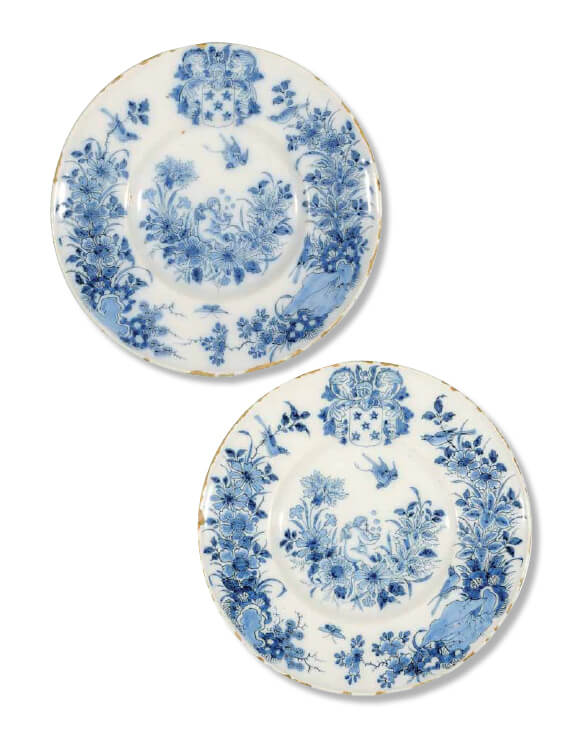D0905. Pair of Blue and White Armorial Plates
€11.500,00
Delft, circa 1685
Attributed to De Grieksche A (The Greek A) Factory
Each painted in the center with a bird flitting above Cupid blowing bubbles and seated amidst a spray of lilies, a carnation and other large blossoms and leaves, the top of the wide rim with an unidentified coat of arms depicting five pierced mullets in a scroll-mantled shield surmounted by a helmet with a wreath and winged crest, and the sides with flowering plants perched upon by birds and growing from behind rockwork near a winged insect at the bottom.
Dimensions
Diameters: 25.8 and 26.1 cm. (10 3/16 and 10 1/4 in.)
无货
描述
Note
This pair of blue and white armorial plates sis depicted with Cupids blowing bubbles with a mixture of soap, which would be kept in a mussel shell or wooden cup from which the bubbles were blown with a straw. This scene of Cupids blowing bubbles is iconographically known as ‘Homo bulla’ (‘Man is a bubble’), which is an allegorical vanitas illustrating the transitoriness of human life.
Images of bubbles were largely used in vanitas, a type of symbolic work of art especially associated with 17th-century still life painting. The Latin word vanitas means ‘vanity’ and loosely translated corresponds to the meaninglessness of earthly life and the transient nature of vanity. In the 17th century Dutch artists used several symbols as a reminder of the transitoriness of human life, such as skulls (referring tot the certainty of death), smoke, watches and hourglasses (referring to the brevity of life), musical instruments (referring to the brevity and the ephemeral nature of life), rotten fruit and peeled lemons (the first refers to decay and the latter is like life, attractive to look at, but bitter to taste, and as just mentioned bubbles. Sometimes bubbles can be seen in still life paintings, but more often this symbol is used in portraits or so-called genre-paintings. For example, the painting ‘A boy blowing bubbles’ of Frans van Mieris the Elder (1635-1682) dated 1663, in the Mauritshuis, The Hague, is a well-known illustration of the allegory. Both children in contemporary dresses or putti are depicted blowing bubbles to convey the brevity of human life, the transience of beauty and the inevitability of death. The soap bubble exists for just a couple of seconds, a perfect sphere, reflecting and refracting its surroundings beautifully. Due to the dryness of the air surrounding the soap bubble, and the pull of gravity, the bubble eventually bursts. It was almost as if the bubble had never existed. It is a reference not only to the brevity of life, but also the suddenness of death.




